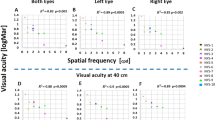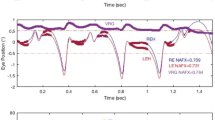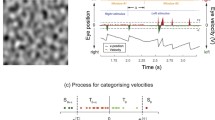Summary
In afoveate animals, and in neonatal or cortically deficient foveate animals, monocular optokinetic nystagmus (OKN) is controlled by directly innervated subcortical nuclei and occurs only in response to temporonasal motion. In higher mammals, the subcortical nuclei receive direct inputs predominantly from the nasal hemiretinae and indirect inputs from the visual cortex. These indirect inputs counterbalance the directional asymmetry of the primitive mechanism. These facts lead to the prediction that the velocity of the slow phase of OKN in the normal human adult should be higher for stimuli moving centripetally rather than centrifugally in each monocular and binocular hemified. The predicted patterns of directional preponderance were found in both monocular and binocular hemifields. Directional asymmetries were still present in monocular hemifields when the central retina was occluded and were reduced when the stimulus was confined to a narrow central strip of the visual field. These results are discussed in terms of the contributions of the central and peripheral retina to directional preponderance.
Similar content being viewed by others
References
Anstis SM, Comerford JP (1975) A simple method of projecting Mach Bands, color mixtures, and variable contrast sinusoidal gratings. Behav Res Meth Instrum 7: 283–287
Atkinson J (1979) Development of optokinetic nystagmus in the human infant and monkey infant: an analogue to development in kittens. In: Freeman RD (ed) Developmental neurobiology of vision. Plenum, New York, pp 277–287
Benevento LA, Rezak M, Santos-Anderson R (1977) An autoradiographic study of the projections of the pretectum in the rhesus monkey (Macaca mulatta): evidence for sensorimotor links to the thalamus and oculomotor nuclei. Brain Res 127: 197–218
Cazin L, Precht W, Lannou K (1980) Optokinetic responses of vestibular nucleus neurons in the rat. Pflug Arch Ges Physiol 38: 31–38
Collewijn H (1975) Direction-selective units in the rabbit's nucleus of the optic tract. Brain Res 100: 489–508
Collewijn H, Holstege G (1984) Effects of neonatal and late unilateral enucleation on optokinetic responses and optic nerve projections in the rabbit. Exp Brain Res 57: 138–150
Dubois MFW, Collewijn H (1979) Optokinetic reactions in man elicited by localized retinal stimuli. Vision Res 19: 1105–1115
Estañol B, Romero R, de Viteri MS, Mateos JH, Corvera J (1980) Oculomotor and oculovestibular functions in a hemispherectomy patient. Arch Neurol 37: 365–368
Gassel MM, Williams D (1963) Visual function in patients with homonymous hemianopia. II. Oculomotor mechanisms. Brain 86: 1–36
Giolli RA, Tigges J (1970) The primary optic pathways and nuclei of primates. In: Norback CR, Montagna W (eds) The primate brain: advances in primatology, Vol 1. Appleton Century Crofts, New York, pp 29–54
Harris LR, Leporé F, Guillemot JP, Cynader M (1980) Abolition of optokinetic nystagmus in the cat. Science 210: 91–92
Hendrickson A, Wilson ME, Toyne MJ (1970) The distribution of optic nerve fibres in Macaca mulatta. Brain Res 23: 425–427
Hoffmann KP (1979) Optokinetic nystagmus and single-cell responses in the nucleus tractus opticus after early monocular deprivation in the cat. In: Freeman RD (ed) Developmental neurobiology of vision. Plenum, New York, pp 63–72
Hoffmann KP, Stone J (1985) Retinal input to the nucleus of the optic tract of the cat assessed by antidromic activation of ganglion cells. Exp Brain Res 59: 395–403
Hoffmann KP, Distler C (1986) The role of direction selective cells in the nucleus of the optic tract of cat and monkey during optokinetic nystagmus. In: Keller EL, Zee DS (eds) Adaptive processes in visual and oculomotor systems (in press)
Howard IP (1982) Human visual orientation. Wiley, London
Howard IP, Gonzalez E (1985) Optokinetic nystagmus and stereoscopic vision. Invest Ophthalmol Vis Sci 26: (ARVO Suppl) 256
Howard IP, Ohmi M (1984a) Directional preponderance of optokinetic nystagmus in normal adults. Invest Ophthalmol Vis Sci 25: (ARVO Suppl) 230
Howard IP, Ohmi M (1984b) The efficiency of the central and peripheral retina in driving human optokinetic nystagmus. Vision Res 24: 969–976
Klooster J, Van der Wont JJL, Vrensen G (1983) Retinoprectal prosections in albino and pigmented rabbits: an autoradio graphic study. Brain Res 288: 1–12
Lynch JC, McLaren JW (1983) Optokinetic nystagmus deficits following parieto-occipital cortex lesions in monkeys. Exp Brain Res 49: 125–130
Mehdorn E (1982) Nasal-temporal asymmetry of the optokinetic nystagmus after bilateral occipital infarction in man. In: Lennerstrand G, Zee DS, Keller EL (eds) Functional basis of ocular motility disorders. Pergamon, Oxford, pp 321–324
Montarolo W, Precht W, Strata P (1981) Functional organization of the mechanisms subversing the optokinetic nystagmus in the cat. Neuroscience 6: 231–246
Naegele JR, Held R (1982) The postnatal development of monocular optokinetic nystagmus in infants. Vision Res 22: 341–346
Precht W, Montarolo PG, Strata P (1980) The role of the crossed and uncrossed retinal fibres in mediating the horizontal optokinetic nystagmus in the cat. Neurosci Lett 17: 39–42
Scalia F (1972) The termination of retinal axons in the pretectal region of mammals. J Comp Neurol 145: 223–256
Schor CM, Levi DM (1980) Disturbances of small-field horizontal and vertical optokinetic nystagmus in amblyopia. Invest Ophthalmol 19: 668–683
Tauber ES, Atkin A (1968) Optomotor responses to monocular stimulation relation to visual system organization. Science 160: 1365–1367
Troost BT, Daroff RB, Weber RB, Dell'Osso LF (1972) Hemispheric control of eye movements. II. Quantitative analysis of smooth pursuit in a hemispherectomy patient. AMA Arch Neurol 27: 449–452
Van Die G, Collewijn H (1982) Optokinetic nystagmus in man. Hum Neurobiol 1: 111–119
Van Hof-Van Duin J (1978) Direction preference of optokinetic responses in monocularly tested normal kittens and light deprived cats. Arch Ital Biol 116: 463–470
Westall CA, Schor CM (1985) Asymmetries of optokinetic nystagmus in amblyopia: The effect of selected retinal stimulation. Vision Res 25: 1431–1438
Author information
Authors and Affiliations
Additional information
This study is part of DCIEM research contract 97711-3-7595/ 8SE83-00221 and was also supported by NSERC grant A0195
Rights and permissions
About this article
Cite this article
Ohmi, M., Howard, I.P. & Eveleigh, B. Directional preponderance in human optokinetic nystagmus. Exp Brain Res 63, 387–394 (1986). https://doi.org/10.1007/BF00236857
Received:
Accepted:
Issue Date:
DOI: https://doi.org/10.1007/BF00236857




